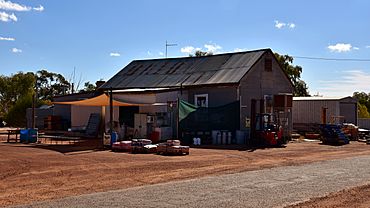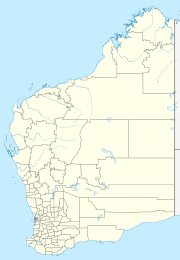Yelbeni, Western Australia facts for kids
Quick facts for kids YelbeniWestern Australia |
|
|---|---|

Yelbeni Store
|
|
| Established | 1912 |
| Postcode(s) | 6487 |
| Elevation | 341 m (1,119 ft) |
| Area | [convert: needs a number] |
| Location | |
| LGA(s) | Shire of Trayning |
| State electorate(s) | Central Wheatbelt |
| Federal Division(s) | Durack |
Yelbeni is a small town located in Western Australia. It is about 222 kilometers (138 miles) east-northeast of Perth, the capital city of Western Australia. Yelbeni is part of the Wheatbelt region, an important farming area. In 2006, about 118 people lived in Yelbeni.
Contents
History of Yelbeni
How Yelbeni Started
Yelbeni began as a stop along a railway line. This railway connected the towns of Dowerin and Merredin. In 1910, land was set aside for the town. It was officially surveyed and named in 1912.
The Name Yelbeni
The town was first going to be called Yelbene. However, its name was changed to Yelbeni before it became official. This change helped people say the name more easily. The name "Yelbeni" comes from the Aboriginal language. It is linked to a nearby place called Yelbene Well. The exact meaning of the name is not known today.
Yelbeni Town Hall
The Yelbeni town hall was built by local people in 1913. It has a wooden frame and its outside walls are made of corrugated iron. Even though it has been made bigger over the years, the original building is still standing. It is being considered for a special list called the State Register of Heritage Places. This list protects important historical buildings.
Grain Handling in Yelbeni
In 1932, the Wheat Pool of Western Australia announced a plan for Yelbeni. The town would get two large grain elevators at the railway stop. These elevators help store and move grain. Each elevator had an engine to help it work. Yelbeni was one of the first five railway stops in Western Australia to use this new way of handling grain in bulk.
Yelbeni's Name on a Train
In 2012, a special train was named after Yelbeni. This train was a CBH class standard gauge locomotive. Its number was CBH 122. Naming trains after towns is a way to honor their connection to the railway and the region's farming history.
Images for kids



